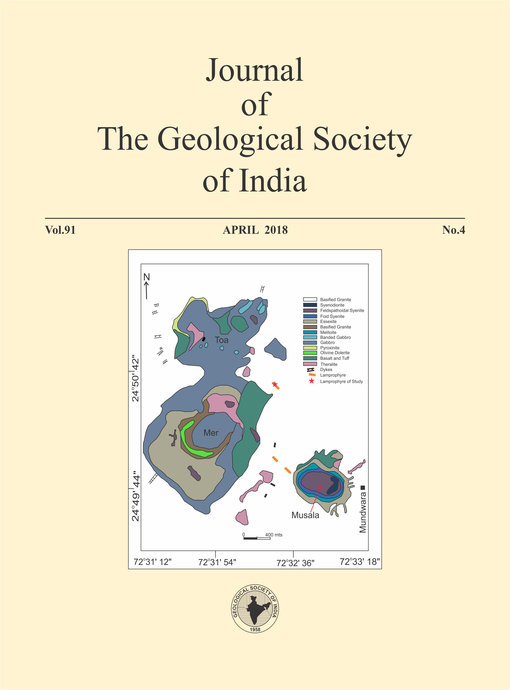Is the Satpura "Horst” in Fact a Compressional Uplift?
DOI:
https://doi.org/10.1007/s12594-018-0870-5Abstract
The >600-km-long Satpura mountain range of central India is usually considered as a horst, separated by normal faults from the Tapi and Narmada grabens. Numerous geological observations and seismicity suggest that a fundamentally different scenario is possible: the arcuate Satpura range may be a large-scale compressional uplift, riding over a north-dipping Satpura-Tapi boundary thrust, akin to the thrust-bounded regional-scale anticlines of the Columbia river flood basalt province. Erosion of the southern front of the Satpuras produces a large fault-line scarp, an illusory normal fault; close parallels exist in the Himalaya and Kachchh. The Satpura-Tapi boundary thrust is blind, buried under the post-Deccan Tapi alluvium, but periodically active, and the Tapi valley has significant seismic risk.Downloads
Metrics
Issue
Section
Downloads
Published
How to Cite
References
Auden, J. B. (1949) Dykes in western India ” a discussion of their relationships with the Deccan Traps. Trans. Nat. Inst. Sci. India, v.3, pp.123–157.
Bhattacharjee, D., Jain, V., Chattopadhyay, A., Biswas, R. H. and Singhvi, A. K. (2016) Geomorphic evidences and chronology of multiple neotectonic events in a cratonic area: results from the Gavilgarh Fault Zone, central India. Tectonophysics, v.677-678, pp.199–217.
Bilham, R., 1998. Slip parameters for the Rann of Kachchh, India, 16 June 1819, earthquake, quantified from contemporary accounts. In: Stewart, I. and Vita-Finzi, C. (Eds.), Coastal Tectonics. Geol. Soc. London Spec. Publ., v.146, pp.295–318.
Bilham, R. and Gaur, V.R. (2000) Geodetic contributions to the study of seismotectonics in India. Curr. Sci., v.79, pp.1259–1269.
Bilham, R., Bendick, R. and Wallace, K. (2003) Flexure of the Indian Plate and intraplate earthquakes. Proc. Indian Acad. Sci. (Earth Planet. Sci.), v.113, pp.315–330.
Chung, W.-Y. (1993) Source parameters of two rift-associated intraplate earthquakes in peninsular India: the Bhadrachalam earthquake of April 13, 1969 and the Broach earthquake of March 23, 1970. Tectonophysics, v.225, pp.219–230.
Chung, W.-Y. and Gao, H. (1995) Source parameters of the Anjar earthquake of July 21, 1956, India, and its seismotectonic implications for the Kutch rift basin. Tectonophysics, v.242, pp.281–292.
Davis, G.H. and Reynolds, S.J. (1986) Structural Geology of Rocks and Regions. J. Wiley & Sons, New York, 776p.
Fermor, L.L. and Cox, C.S. (1916) The Deccan Trap flows of Linga, Chhindwara District, Central Provinces. Rec. Geol. Surv. India, v.47, pp.81-136; reprinted in Subbarao, K.V. (Ed.), Deccan Volcanic Province. Mem. Geol. Soc. India, no.43(1), pp.81–101.
Guha, S. (1995) Tectonic framework and evolution of the Tapi basin – an intracratonic half-graben from west-central India. Indian Minerals, v.49, pp.61–78.
Karanth, R.V. and Gadhavi, M.S. (2007) Structural intricacies: emergent thrusts and blind thrusts of central Kachchh, western India. Curr. Sci., v.9, pp.1271–1280.
Malik, J.N., Sahoo, A.K., Shah, A.A., Shinde, D.P., Juyal, N. and Singhvi, A.K. (2010) Palaeoseismic evidence from trench investigation along Hajipur fault, Himalayan Frontal Thrust, NW Himalaya: implications of the faulting pattern on landscape evolution and seismic hazard. Jour. Struc. Geol., v.32, pp.350–361.
Mandal, P., Rastogi, B.K. and Gupta, H. K. (2000) Recent Indian earthquakes. Curr. Sci., v.79, pp.1334–1346.
Mathew, G., Singhvi, A.K. and Karanth, R.V. (2006) Luminescence chronometry and geomorphic evidence of active fold growth along the Kachchh Mainland Fault (KMF), Kachchh, India: seismotectonic implications. Tectonophysics, v.422, pp.71–87.
Pati, P., Parkash, B., Awasthi, A. K., Acharya, V. and Singh, S. (2011) Concealed thrusts in the Middle Gangetic plain, India – a ground penetrating radar study proves the truth against the geomorphic features supporting normal faulting. Jour. Asian Earth Sci., v.40, pp.315–325.
Qureshy, M. N., 1971. Relation of gravity to elevation and rejuvenation of blocks in India. J. Geophys. Res., v. 76, pp. 545–557.
Rajendran, K. and Rajendran, C.P. (1999) Seismogenesis in the stable continental interiors: an appraisal based on two examples from India. Tectonophysics, v.305, pp.537–551.
Ray, R., Sheth, H.C. and Mallik, J. (2007) Structure and emplacement of the Nandurbar-Dhule mafic dyke swarm, Deccan Traps, and the tectonomagmatic evolution of flood basalts. Bull. Volcanol., v.69, pp.537–551.
Rao, B.R. and Rao, V.K. (2006) Influence of fluids on deep crustal Jabalpur earthquake of 21 May, 1997: geophysical evidences. Jour. Seismol., v.10, pp.301–314.
Reidel, S.P., Martin, B.S. and Petcovic, H.L. (2003) The Columbia River flood basalts and the Yakima fold belt. In: Swanson, D.W. (Ed.), Western Cordillera and Adjacent Areas. Geol. Soc. Amer. Field Guide, v.4, pp.87–105
Reidel, S.P., Camp, V.E., Tolan, T.L., Kauffman, J.D. and Garwood, D.L., (2013) Tectonic evolution of the Columbia River flood basalt province. In: Reidel, S.P., Camp, V.E., Ross, M.E., Wolff, J.A., Martin, B.S., Tolan, T.L. and Wells, R.E. (Eds.), The Columbia River Flood Basalt Province. Geol. Soc. Amer. Spec. Paper, v.497, pp.293–324.
Shanker, R. (1987) Neotectonic activity along the Tapti-Satpura lineament in central India. Indian Minerals, v.41, pp.19–30.
Sheth, H. C., 1998. Geochemistry, Petrogenesis, Stratigraphy and Structure of Deccan flood basalts of the western Satpura-Tapi region, India. Ph.D. dissertation, Indian Institute of Technology Bombay.
Sheth, H.C., Ray, J.S., Ray, R., Vanderkluysen, L., Mahoney, J.J., Kumar, A., Shukla, A.D., Das, P., Adhikari, S. and Jana, B. (2009) Geology and geochemistry of Pachmarhi dykes and sills, Satpura Gondwana Basin, central India: problems of dyke-sill-flow correlations in the Deccan Traps. Contrib. Mineral. Petrol., v.158, pp.357–380.
Subrahmanya, K.R. (1996) Active intraplate deformation in south India. Tectonophysics, v.262, pp.231–241.
Surendranath, M. (1984) Geomorphology of the Tapti Valley. Ph.D. dissertation, Indian Institute of Technology Bombay.
Valdiya, K.S. (2003) Reactivation of Himalayan Frontal Fault: implications. Current Sci., v. 85, 1013–1040.
Valdiya, K. S., 2010. The Making of India: Geodynamic Evolution. Macmillan, 816p.
Venkatakrishnan, R. (1984) Parallel scarp retreat and drainage evolution, Pachmarhi area, Madhya Pradesh, central India. Jour. Geol. Soc. India, v.25, pp.401–413.
Vita-Finzi, C. (2002) Intraplate neotectonics in India. Curr. Sci., v.82, pp.389–391.
Vita-Finzi, C. (2004) Buckle-controlled seismogenic faulting in peninsular India. Quat. Sci. Rev., v.23, pp.2405-2412.

 Hetu Sheth
Hetu Sheth






